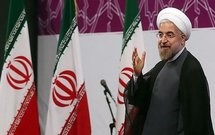 With a landmark Afghan presidential election fast approaching, soon to be followed by the Western military withdrawal from the country, Tehran has stepped up efforts towards securing a stable and favourable government in Kabul. Iran’s interests in Afghanistan are many and wide-ranged.
With a landmark Afghan presidential election fast approaching, soon to be followed by the Western military withdrawal from the country, Tehran has stepped up efforts towards securing a stable and favourable government in Kabul. Iran’s interests in Afghanistan are many and wide-ranged.
Geostrategic Calculations
Iran’s interests in Afghanistan can be categorised into economy, strategy, and its larger agenda vis-à-vis South and Central Asia Developments – positive or negative – on any of these fronts holds implications for the others.
Assuming that Afghanistan will not entirely de-stabilise after 2014, greater Iranian investment in and spreading outwards from central Afghanistan can be expected. Iranian influence in Afghanistan’s Herat province is already tremendous, with several million dollars’ worth investment and robust cross-border trade; and Tehran definitely wants to make more inroads – although they are not the most favoured, if not disapproved of, by the Afghans.
Afghanistan is Iran’s gateway to the larger Central Asian region and China. It is already working towards instituting a North-South corridor between the Central Asian States, Afghanistan, China, and the greater West Asia and North Africa, using Chabahar Port on its southern border –thereby luring these countries away from their dependence on Pakistan’s restive South for their access to sea lanes.
At present, there are over 7,80,000 Afghan refugees living in Iran. Eventually, some of them will return to their homeland, and they will take with them the education, experience and other such soft-power baggage that they would have gained during their time in Iran. Tehran already has an upper hand owing to linguistic proximity between Dari and Persian. Furthermore, a considerable number of Afghans – 19 per cent of the total population – are Shia Muslims, and Iran is a pre-eminent Shia State – easing Iran’s inroads into Afghanistan.
Among the several outstanding issues that it would want resolved are: consensus on water-sharing; return of Afghan refugees; an end to cross-border drugs and arms smuggling in its southern borders.
Linear Algebra, Not Quadratic Equations
Tehran’s Afghan calculations will not be a simple exercise to conduct. The region is not presenting a simple quadratic equation. On the contrary, the complex array of factors operational in the region is somewhat like linear algebra: i.e. involving several unknowns. Many of Iran’s subsequent moves will depend on the fate of: the US-Afghanistan Bilateral Security Agreement (BSA); Saudi Arabian manoeuvres in Pakistan and the region; Pakistan’s dealings with home-grown terrorism; and most importantly, the results of the upcoming Afghan presidential elections.
Most Afghans want to sign the BSA for the security of their nation, but for Iran, it would spell a constant US presence in their immediate neighbourhood. Unsurprisingly, given its suspicions of Washington’s motives, it does not support the signing of the agreement.
The increasing proximity between Saudi Arabia and Pakistan, evident from but not limited to the Riyadh-Islamabad bilateral exchanges in the past few weeks, could lead to Iran upping its ante in its efforts towards bringing Afghanistan under its influence, and it could lead to some tensions between Washington and Tehran. However, although Iran, in a play of realpolitik and keeping aside ideology, will be willing to ally with an ideologically opposed and Saudi-sponsored Taliban and/or another extremist groups to an exten, to supply irritants for the US, it most definitely will not let the situation escalate beyond what it can control. While the US should only be relieved that Iran would not let the situation spiral out of control, Washington’s inherent paranoia – coupled with the knowledge that the BSA will be signed after the Afghan presidential elections – will not let it relax. The post-BSA state-of-affairs will yet again be a complex unknown; especially with the potential of Russia’s role in the Ukraine crisis to complicate the US withdrawal.
For Tehran, the Taliban is an expendable pawn in the context of its security interest. Hence, although it might become flexible for a while, that flexibility will only be temporary, and will wither away soon after the withdrawal of international forces. That juncture is when the difference in the ideologies of the Shia-majority Iran and the Sunni/Wahabi Saudi-backed-Taliban will again take precedence.
The temporariness and selectiveness of support to militant Islamists has been made evident in Iranian Interior Minister Abdolreza Rahmani Fazli’s hard talk addressed to Pakistan over Jaish-ul-Adl’s kidnapping of Iranian border guards in its Sistan Baluchestan province bordering Pakistan’s Balochistan province.
Iran’s Sunni-majority Sistan Baluchestan province borders Pakistan’s restive Balochistan province that in turn borders Afghanistan’s most turbulent provinces, Kandahar and Helmand. Instability in Pakistan’s internal security vis-à-vis this tri-national border region and the associated illicit cross-border arms and drugs trade is a major irritant for Iran. With a Saudi-influenced government in Pakistan being an undependable option for Tehran to negotiate with – given that Islamabad does not crack down on those militant groups funded and supported by Riyadh in return for political and economic favours – Iran’s only hope is a favourable government in Afghanistan.
Expect a lot of drama in the region – Iran, Af-Pak, and Central Asia – over the next three months, and hopefully, the bands of militiamen running amok in the region will not be the ones to make the most of it.
By Special Arrangement with Institute of Peace and Conflict Studies (http://www.ipcs.org)